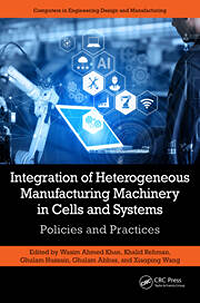Integration of Heterogeneous Manufacturing Machinery in Cells and Systems Policies and Practices
Material type: TextLanguage: English Series: Computers in Engineering Design and ManufacturingPublication details: Boca Raton, FL: CRC Press, 2024Description: xxvii, 241 p. : illISBN:
TextLanguage: English Series: Computers in Engineering Design and ManufacturingPublication details: Boca Raton, FL: CRC Press, 2024Description: xxvii, 241 p. : illISBN: - 9781032444659
- 670.4275 KHA
| Item type | Current library | Shelving location | Call number | Status | Date due | Barcode |
|---|---|---|---|---|---|---|
 Reference Collection
Reference Collection
|
Reference Section | Reference Section | 670.4275 KHA | Available | 98748 |
Biography
Professor Dr. Wasim A. Khan
Wasim A. Khan has researched and developed industrial scale subtractive and additive manufacturing machine tools, measurement, and testing machines as well as digital controllers for this equipment. He is instrumental in policies and framework development related to manufacturing of discrete products in small, medium, and large-scale manufacturing enterprises at national level. Dr. Wasim is a life member of Pakistan Engineering Council, a chartered engineer of Engineering Council, UK and a fellow of Institution of Mechanical Engineers, UK. He is also a senior member of IEEE, USA. He is currently acting as Professor of Operations Research at the GIK Institute of Engineering Sciences and Technology, Pakistan.
Dr. Khalid Rahman
Khalid Rahman is an Associate Professor in the Faculty of Mechanical Engineering at Ghulam Ishaq Khan Institute of Engineering Sciences and Technology where he has been a faculty member since 2012. He received his BS in Mechanical Engineering from Ghulam Ishaq Khan Institute of Engineering Sciences and Technology, MS and PhD degree from Jeju National University, South Korea in 2012. He also has industrial experience of seven years in design and manufacturing. His research interests include printing technologies, and he is currently working on Direct Ink Write and Electrohydrodynamic inkjet printing for fabrication of electronics devices and sensors and applications.
Professor Dr. Ghulam Hussain
Dr. Ghulam Hussain is a professor of mechanical engineering at the University of Bahrain, Bahrain. He has rich experience of both academia and industry. He is an expert of manufacturing technologies with expertise in plasticity, sustainability, and advanced processes including 3D printing, incremental forming, friction welding and hybridization. He is the author of over 100 top-notch journal articles and an editor of several books. He is recognized among the top 10 leading researchers at the international as well as national level. He has been ranked as the world’s top 2% scientist by Stanford University, USA. He is the winner of many research and teaching awards/prizes. He is actively involved with several reputed international universities as a foreign expert and external researcher.
Dr. Ghulam Abbas
GHULAM ABBAS received the B.S. degree in computer science from University of Peshawar, Pakistan, in 2003, and the M.S. degree in distributed systems and the Ph.D. degree in computer networks from the University of Liverpool, U.K., in 2005 and 2010, respectively. From 2006 to 2010, he was Research Associate with Liverpool Hope University, U.K., where he was associated with the Intelligent & Distributed Systems Laboratory. Since 2011, he has been with the Faculty of Computer Sciences & Engineering, GIK Institute of Engineering Sciences and Technology, Pakistan. He is currently working as Professor and Director Huawei ICT Academy. Dr. Abbas is a Co-Founding Member of the Telecommunications and Networking Research Center at GIK Institute. He is a Fellow of the Institute of Science & Technology, U.K., a Fellow of the British Computer Society, and a Senior Member of the IEEE. His research interests include computer networks and wireless and mobile communications.
Professor Dr. Wang Xiaoping
Wang Xiaoping is a professor at college of Electrical and Mechanical Engineering, Nanjing University of Aeronautics and Astronautics, a senior member of Chinese Mechanical Engineering Association, a senior member of Aeronautical Society, a guest editor of international journal IJCAT, an editorial board member of American Journal of Software Engineering and Applications, and an evaluation expert of postgraduate dissertation of Ministry of Education. His main research areas include digital design and manufacturing, and intelligent manufacturing. The current research interests are reverse engineering, aerial measurement, geodetic model reconstruction (3D reconstruction); composite material fiber laying process / robot road planning; NC machining tool rail planning / material reduction and material increase manufacturing path optimization; CAD software system integration and algorithm; mathematical modeling; Other theoretical and technical issues related to mechanical design and manufacturing. He has executed several research projects funded by national agencies. He is also winner of 3 National Defense Science and Technology Progress Awards, 1 Provincial Award and 1 Municipal Award. He has published more than 80 research articles in renowned journals and has 2 patents to his credit.
With the advent of the 4th Industrial Revolution, the implementation of the nine pillars of technology has taken a firm root, especially after the post-COVID pandemic era. The integration of cyber-physical systems is one of the most important pillars that has led to the maximization of productivity, which also leads to the maximization of profits from a manufacturing system. This book discusses manufacturing enterprises, then looks at the theoretical and practical aspects of integrating these manufacturing systems using legacy and modern communication methodologies and relates them to the current level of technology readiness.
Integration of Heterogenous Manufacturing Machinery in Cells and Systems: Policies and Practices focuses on the methods covering the use of Artificial Intelligence, Augmented Reality, the Internet of Things, and cellular and physical industrial communication. It describes the nine pillars of technology which include the Internet of Things, Cloud Computing, Autonomous, and Robotics Systems, Big Data Analytics, Augmented Reality, Cyber Security, Simulation, System integration, and Additive Manufacturing. The book highlights the methods used that cover mechanical, electrical, electronics, and computer software aspects of developing manufacturing machinery and discusses computer-aided design (CAD), production planning, and manufacturing, as well as production databases with basics and semantics.
This book is an ideal reference for undergraduate, graduate, and postgraduate students of industrial, manufacturing, mechanical, and mechatronics engineering, along with professionals and general readers.
